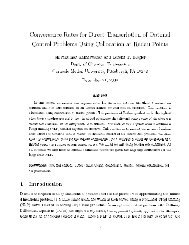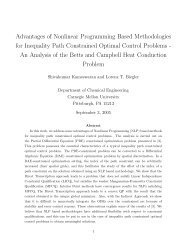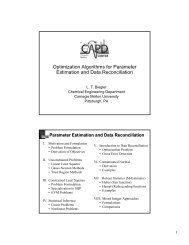MPEC Problem Formulations in Chemical Engineering Applications
MPEC Problem Formulations in Chemical Engineering Applications
MPEC Problem Formulations in Chemical Engineering Applications
Create successful ePaper yourself
Turn your PDF publications into a flip-book with our unique Google optimized e-Paper software.
Simplify<strong>in</strong>g the complementarity conditions to elim<strong>in</strong>ate the variable y <strong>in</strong>the first two equations leads to:z = f(x) + s b , f(x) − z a = s a − s b (33)0 ≤ s b ⊥ s a ≥ 0• The m<strong>in</strong> operator y = m<strong>in</strong> (f(x), y b ) can be treated <strong>in</strong> a similar way bydef<strong>in</strong><strong>in</strong>g the problem:z = f(x) + (f(x) − z b )yy = arg{m<strong>in</strong>ŷ(f(x) − z b )ŷ s.t. 0 ≤ ŷ ≤ 1} (34)Apply<strong>in</strong>g the KKT conditions and simplify<strong>in</strong>g leads to the follow<strong>in</strong>g complementaritysystem:5.2 Flow Reversalz = f(x) + s a , z b − f(x) = s b − s a (35)0 ≤ s b ⊥ s a ≥ 0Flow reversal can occur <strong>in</strong> many places <strong>in</strong> chemical processes <strong>in</strong>clud<strong>in</strong>g fuelheaders and pipel<strong>in</strong>e distribution networks. This is problematic for model<strong>in</strong>gs<strong>in</strong>ce physical properties and other equations implicitly assume the sign of theflowrate to be positive. These situations may be modeled with the absolute valueoperator, us<strong>in</strong>g complementarities as <strong>in</strong> (31). The magnitude of the flowrate canthen be used <strong>in</strong> the sign sensitive equations.On the other hand, it may not be possible to implement these changes <strong>in</strong>some model<strong>in</strong>g environments, such as commercial process optimization softwarewith directional streams and <strong>in</strong>tegrated thermo-physical models. In this case,each stream with the potential for flow reversal can be modeled as two parallelcounter-current streams. The stream flowrates are then complemented, suchthat either one stream or the other has zero flow. Us<strong>in</strong>g mixers and splitters asappropriate, the two streams can then be <strong>in</strong>tegrated <strong>in</strong>to any process flowsheet[9]. While this method may obscure the orig<strong>in</strong>al representation of the system,it rema<strong>in</strong>s equivalent.5.3 Relief Valves, Check Valves, Compressor Kick-BackRelief valves, check valves and compressor kick-back operation are all relatedphenomenon that can be modeled us<strong>in</strong>g complementarities <strong>in</strong> a manner similarto the functions used <strong>in</strong> Section 5.1.• Check valves prevent flows <strong>in</strong> reverse directions that may arise from changes<strong>in</strong> differential pressure. Assum<strong>in</strong>g that the directional flow is a monotonicfunction of the differential pressure, we model flow through the check valveas:flow = max{0, f(∆p)}and rewrite the max operator as the complementarity system given <strong>in</strong> (33).16






